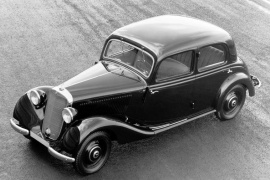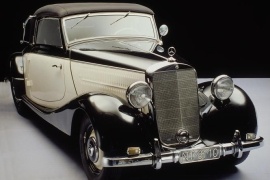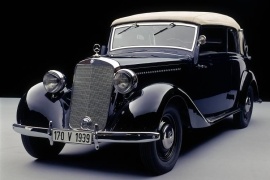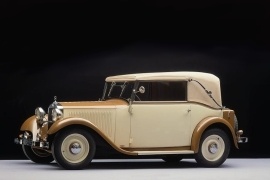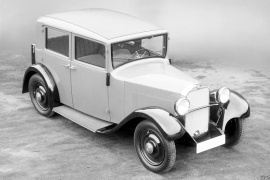MERCEDES BENZ Typ 170/170 V Models/Series Timeline, Specifications & Photos
First production year: 1931
Engines: Hybrid, Gasoline
When Mercedes-Benz introduced the new Typ 170 V at the 1936 International Motor and Motorcycle Show in Berlin, it offered the vehicle in a few body shapes, and the most important was the sedan version.
After the Great Depression, the German automaker focused on luxury vehicles but didn't forget about those who just wanted the three-pointed star on the car's hood but at a lower price. Thus, it produced a lower-grade vehicle that was still able to prove the owner's status in society. And for them was the Typ 170 built. But for that, Mercedes-Benz needed a completely new vehicle designed from scratch. Dr. Hasn Niebel worked together with the designer Max Wagner on the car. They created an innovative frame that was lighter than the previously used one on the Typ 170 (W15) but offered similar strength.
The 1936 Typ 170 sedan featured a front fascia with a tilted radiator flanked by headlights, which were mounted on the sides of the engine compartment. The curved front fenders were continued on the sides by the steps that eased the ingress and egress to the vehicle. Both doors were hinged onto the B-pillar, and the automaker had to create a system that prevented them from hitting one another when opened simultaneously. At the back, the slightly sloped rear end was fitted with an external rack that could host a trunk case.
Inside, the Typ 170 offered enough room for four passengers. The front bucket seats were covered in high-quality vinyl. The same material was used for the rear bench and the door cards. On the dashboard, the automaker installed the main dials and gauges in the middle, not in front of the driver.
With its 1.7-liter engine, the Typ 170 boasted enough performance to attract customers. Moreover, compared to other cars from that era, it was fuel-efficient, a characteristic that helped Mercedes-Benz to sell the Typ 170 in high numbers.
In 1936, at the International Motor and Motorcycle Show in Berlin, Mercedes-Benz showed the 170 V, 170 H, and 260 D lineups. The 170 V was an important model in the company's heritage.
The design of the new 170 V started in 1933 under the direction of chief design engineer Dr. Hans Nibel and designer Max Wagner. The 170 V to be cheaper than a regular Mercedes-Benz, with the engine in the front and it had to be launched in three years. And the result was the 170 V.
The convertible version shared the same chassis with the rest of the W136 range. Despite a longer wheelbase, the new frame was some 50 kg (110.2 lbs) lighter and also stiffer than the box-section frame previously used in the 170. The car featured a long hood, short cabin, and sloped end where the spare-wheel was installed. The specific Mercedes-Benz grille in the front was tall and narrow. Unlike other Mercedes-Benz from that era, the headlights were mounted on the front fenders and not on a chromed bar.
It was the roadster for those who couldn't afford an expensive model and Mercedes-Benz didn't want to lose those customers in favor of BMW, who already had a 2-seat convertible on the market. For those who wished a four-seat cabriolet, Mercedes-Benz built the Cabriolet B, which featured the same chassis and drivetrain, but with a longer cabin and a shorter back.
The 170 Cabriolet A featured an inline-four engine with a 1.7-liter displacement. It was mated to a four-speed gearbox. The Convertible A was the most expensive 170 V. It was fitted with the newly developed rear swing axle, which allowed better comfort and speed cornering.
Mercedes-Benz unveiled the 170 V series at the 1936 International Motor and Motorcycle Show in Berlin and offered it in a wide range of bodyworks, including a four-seat convertible named Cabriolet B.
After the Big Depression in the early 30s, the German automaker unveiled a lower-budget lineup: the 170 V, 170 H, and 260 D. The former was the one that caught up the best from them all, especially since it was available in a few open or closed versions, with two or four doors.
In 1933, Mercedes-Benz's design engineer was Dr. Hans Nibel, who worked with the designer Max Wagner. They started to pen the next vehicle with a completely new frame that was 50 kg (110 lbs) lighter than the former Typ 170 (W15) but also stiffer. Its front fascia featured a tilted radiator flanked by headlights, which were mounted on the sides of the engine compartment. The curved front fenders were continued on the sides by the steps that eased the ingress and egress to the vehicle. A pair of rear-hinged doors allowed access to the cabin. The car's canvas top could have been retracted behind the rear seats, above the trunk.
With its cabin fit for four adults, the Typ 170 V Cabriolet B was suitable for young families who needed a stylish vehicle. At the front, the bucket seats were covered in high-quality vinyl. The same material was used for the rear bench and the door cards. On the dashboard, the automaker installed the main dials and gauges in the middle, not in front of the driver.
With its 1.7-liter engine, the Cabriolet B boasted enough performance to attract customers. Moreover, compared to other cars from that era, it was fuel-efficient, a characteristic that helped Mercedes-Benz to sell the Typ 170 in high numbers.
Mercedes-Benz introduced the Typ 170 range in 1931 and helped the German carmaker survive the Great Depression.
After the Wall Street Crash in late 1929, the effects started to spread worldwide and struck Germany in the summer of 1931. Mercedes-Benz management took the bold move to develop a new, more affordable vehicle and launched it in October at the Paris Motor Show. France was one of the least affected countries by the Great Depression, and it was the right place to unveil a high-quality vehicle at a lower price.
Hans Nibel designed the light car to be affordable and dependable. The small vehicle featured slim and rounded fenders at the front, which supported a transverse chromed bar that kept the electric headlights. A flat and squared radiator surrounded by a chromed rim gave the vehicle an upscale look. After all, it wore the three-pointed star badge on the radiator's cap. In the convertible shape, the Typ 170 featured a flat windshield with two wipers at the top, with its folding roof retractable behind the rear seats. At the back, Mercedes installed a removable trunk, which was accessible from the outside. Starting with the 1934 model, it became attached to the body. Behind it, the carmaker installed the spare wheel.
The small vehicle provided room for four people inside, with two seats at the front and a bench in the rear. Its minimalist design kept the production cost low. Even though it didn't look like one of the flashy Mercedes cars, it provided some premium materials.
The 170 was an innovative vehicle that featured independent suspension in all corners, with swing axles in the rear and a transverse leaf-spring at the front. Its hydraulic braking system was another significant improvement. On top of that, very important for those times, it provided an anti-theft device that locked the steering column when the key was not in the ignition. Mercedes-Benz mated the inline-six engine to a three-speed manual transmission and a fourth overdrive gear for improved fuel efficiency.
In the early 30s, the world struggled with the Great Depression that crumbled companies and individuals, and Mercedes-Benz found a clever solution to thrive: a popular vehicle.
While the luxurious vehicles were no longer in such great demand, the German carmaker decided to introduce the Typ 170 (W15) in the summer of 1931. It was a practical vehicle, without sumptuous amenities, but with advanced technical solutions for those times. Things like independent rear suspension with a swing axle and hydraulic brakes were already known by carmakers. Still, they were usually installed on much more expensive vehicles. And yet, the W15 offered these on a vehicle priced lower than what Mercedes-Benz vehicles used to sell for.
Mercedes-Benz didn't invest too much in the exterior design. It offered the Typ 170 with a simple bodywork that featured shorter, curved front fenders that flanked the tall engine compartment. The flat radiator was surrounded by a chromed trim and, obviously, had the three-pointed-star badge placed on top. The headlights mounted between the fenders, on a slightly upward curved horizontal bar, were already a design signature for Mercedes-Benz and, therefore, used on this car. The four-door sedan featured rear-hinged back doors that facilitated the ingress and egress from the vehicle.
Unlike other vehicles from the carmaker's lineup, the W15 featured an external trunk located behind the vehicle and supporting the spare wheel that couldn't fit on the sides of the engine compartment. Even though it was rather a basic model, the interior was fitted with good quality materials such as leather and wood trims without any flashy design cues.
Under the hood, Mercedes-Benz installed a six-mill engine, although it was a small-displacement unit.
